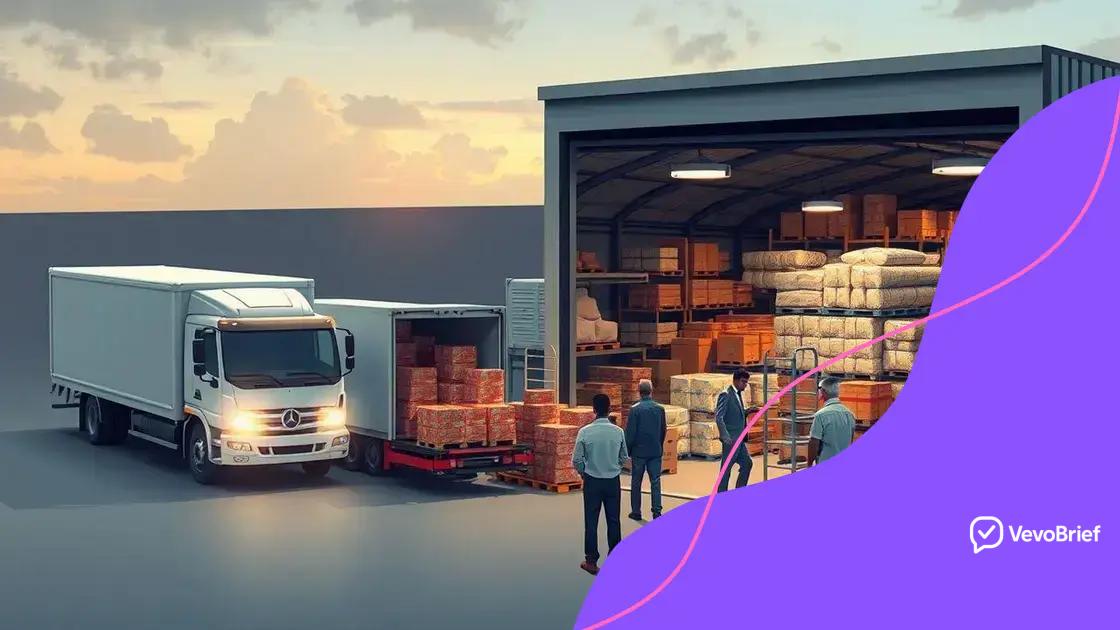Supply chain impact on food aid: what you need to know

The supply chain impact on food aid involves logistics, technology, and community engagement to ensure efficient delivery of food to those in need while addressing sustainability and local sourcing trends.
The supply chain impact on food aid plays a vital role in how food reaches those in need. Ever wondered how logistical hurdles can affect emergency relief? Let’s dive into this complex issue and its implications.
Understanding the supply chain for food aid
Understanding the supply chain for food aid is essential for ensuring that help reaches those in need. Food aid programs rely on a well-organized system to manage the flow of food from producers to communities. By examining the various components of this chain, we can better appreciate its importance and challenges.
Key Components of Food Aid Supply Chains
The supply chain for food aid includes several vital elements. Each component plays a significant role in the overall effectiveness of food distribution. Here are the main parts:
- Producers: Farmers and manufacturers create the food that gets distributed.
- Warehousing: Food is stored in facilities to maintain freshness before being sent out.
- Transportation: Delivery methods are crucial for getting food to areas where it is needed.
- Distribution Centers: These locations manage the logistics of getting food to local agencies and needy communities.
The interaction between these components is complex, and any disruptions can have significant effects. For example, if transportation is delayed, food might spoil before it reaches its destination. This highlights the delicate balance required in the supply chain.
Challenges in Food Aid Supply Chains
There are numerous challenges in managing food aid supply chains. Weather conditions can impact crop yields, while political conflicts may obstruct transportation routes. Organizations must also grapple with limited resources and budget constraints. These factors can make it tough to maintain an efficient system. In addition, keeping track of food safety and quality is a constant concern, as aid organizations strive to provide the best possible help.
Understanding the supply chain dynamics allows for better planning and resource allocation. By addressing these challenges, food aid organizations can improve their strategies. This, in turn, leads to more effective support for individuals and families facing hunger. Recognizing the interconnectedness of each element helps stakeholders work together more efficiently.
Challenges faced in food distribution
Challenges faced in food distribution can significantly impact the efficiency of food aid programs. Many factors contribute to these difficulties, often making it harder to deliver food where it is needed the most. By examining these challenges, we can better understand the logistics of food aid.
Logistical Difficulties
One major hurdle in food distribution is logistics. Getting food from warehouses to communities often involves complex processes. There are transportation issues, such as vehicles breaking down or bad weather affecting travel routes. Each delay can lead to spoiled food and wasted resources.
- Transport Problems: Lack of reliable vehicles and infrastructure.
- Storage Limitations: Insufficient facilities for perishable items.
- Access Issues: Some areas are hard to reach due to geography or conflict.
Additionally, managing inventory can be tricky. Organizations must keep track of what food is available and ensure that it is delivered in a timely manner. This requires efficient communication and organization on all levels.
Resource Constraints
Resource constraints are another challenge that affects food distribution. Many food aid organizations operate on tight budgets. This can limit their ability to hire enough staff or maintain vehicles. Without adequate resources, it’s hard to ensure that food reaches those who need it. Training for staff members is also essential, as skilled workers can make a significant difference in navigating complex situations.
Moreover, political conflicts can disrupt supply chains. Wars or civil unrest may close off essential routes or delay shipments. As a result, food aid organizations often have to find creative ways to work around these obstacles. Building relationships with local communities may help to facilitate smoother deliveries, but this takes time and effort.
If we analyze these challenges, we see how interrelated they are. By addressing logistical difficulties and resource constraints, food aid organizations can improve their distribution effectiveness. This ultimately leads to better support for those facing hunger.
The role of logistics in food aid

The role of logistics in food aid is crucial to ensuring that food reaches those in need efficiently. Logistics involves the planning, implementation, and management of how food is distributed. Without effective logistics, even the best food aid programs can struggle to meet their goals.
Key Elements of Logistics in Food Aid
Several key elements define the logistics involved in food aid distribution. Each of these elements contributes to the overall success of getting food from producers to recipients.
- Transportation: Efficient transportation is vital. This includes choosing the right vehicles and routes to deliver food safely and timely.
- Warehousing: Food must often be stored before distribution. Proper warehousing maintains food quality and safety during storage.
- Inventory Management: Knowing what food is available and its location helps streamline the distribution process.
- Technology: Using technology can enhance tracking systems and improve communication among partners.
In essence, these elements work together to create an effective food aid system. By focusing on logistics, organizations can improve their response times and adapt to changing needs in communities.
Importance of Coordination
Coordination among various stakeholders plays a significant role in logistics for food aid. This includes collaboration between governments, non-profits, and local organizations. When everyone works together, it helps avoid duplication of efforts and ensures that resources are used effectively. For example, local organizations often have better knowledge of the communities they serve, which helps guide logistical decisions.
Timely sharing of information is also crucial. When logistics teams and food providers communicate clearly, they can respond quickly to any obstacles. These might include sudden weather changes or transportation issues. This ability to adapt can greatly enhance the success of food distribution.
Overall, the role of logistics in food aid cannot be understated. It is essential for providing a lifeline to those facing hunger and ensuring that food aid reaches the most vulnerable populations quickly and effectively.
Innovative solutions to improve aid delivery
Innovative solutions to improve aid delivery are essential in ensuring food reaches those who need it most. Technology and new methods can make a significant difference in how food aid is provided. These innovations help address various challenges faced in the food supply chain.
Use of Technology
Employing technology is one of the most effective ways to enhance aid delivery. Tools like mobile apps and GPS tracking systems can help organizations monitor shipments and manage inventory. This increases transparency and helps in planning.
- Mobile Applications: Apps can connect donors with local organizations, making it easier to coordinate food donations.
- Data Analytics: Using data helps organizations understand food needs in different areas, ensuring the right amount of food is sent.
- Blockchain Technology: This can improve traceability, helping to track food from producer to consumer.
These technological advancements facilitate better communication among all stakeholders in the food aid process. In turn, this increases efficiency and reduces waste.
Community Engagement
Another innovative solution is community engagement. Involving local communities in food distribution helps organizations tailor their aid strategies to meet specific needs. When community members participate, they often provide valuable insights that can enhance the delivery process. Creating local partnerships can also strengthen the support system for food aid.
Furthermore, training local volunteers can improve distribution effectiveness. These volunteers understand cultural norms and can navigate local challenges with ease. Their involvement ensures that food reaches the most vulnerable populations quickly and effectively.
Implementing innovative solutions in aid delivery showcases the adaptive strategies that organizations can employ. By combining technology and community involvement, food aid programs can become more responsive to the needs of those they serve. Embracing change can significantly enhance the overall success of food distribution efforts.
Future trends in food aid supply chains
Future trends in food aid supply chains are shifting as new challenges and technologies emerge. As global needs change, food aid organizations are adapting their strategies to deliver more effective assistance. Understanding these trends can help enhance the efficiency and impact of food distribution efforts.
Emphasis on Sustainability
One significant trend is the growing emphasis on sustainability. Organizations are increasingly aware of the environmental impact of food distribution. This awareness drives them to adopt sustainable practices that minimize waste. For instance, many groups are looking at ways to reduce packaging or source food locally.
- Local Sourcing: Choosing food producers close to the aid areas can reduce transportation emissions.
- Waste Reduction: Implementing methods to recycle or repurpose unused food helps combat waste.
- Eco-friendly Packaging: Using biodegradable materials for packaging is becoming more common.
By focusing on sustainability, organizations not only benefit the environment but also improve community relations.
Technological Advancements
Another trend shaping the future of food aid supply chains is the use of cutting-edge technology. Innovations in logistics, such as automated tracking systems, play a vital role. Enhanced tracking allows for better management of food supplies and more accurate delivery times.
Additionally, technologies like artificial intelligence are being used to analyze data and improve decision-making. By understanding patterns in food needs, organizations can optimize their supply chains more effectively. This results in quicker responses to crises and better allocation of resources.
Collaboration platforms are emerging as well, allowing organizations to share information and strategies. When groups work together and share resources, the impact of food aid increases. This collaborative approach is vital in reaching those in need more efficiently.
As we look to the future, the trends in food aid supply chains show a clear direction toward innovative practices and technologies. Organizations that embrace these changes will likely enhance their effectiveness and improve outcomes for communities worldwide.
FAQ – Frequently Asked Questions about Food Aid Supply Chains
What is the role of logistics in food aid?
Logistics ensures efficient planning and management of food distribution, helping food reach those in need timely.
How can technology improve food aid delivery?
Technology enhances tracking and communication, allowing for better inventory management and quicker response times.
Why is community engagement important in food aid?
Involving local communities helps tailor aid strategies to specific needs, increasing the effectiveness of food distribution.
What are some future trends in food aid?
Future trends include a focus on sustainability, local sourcing, and the use of advanced technologies for better logistics.
